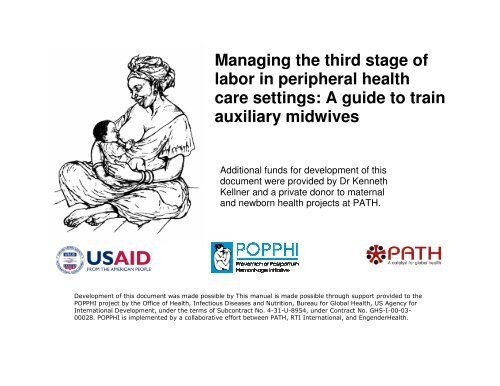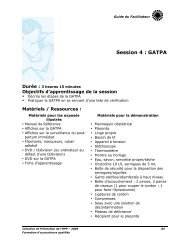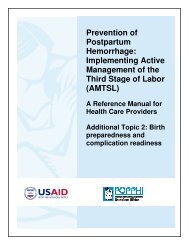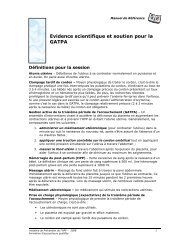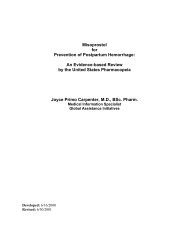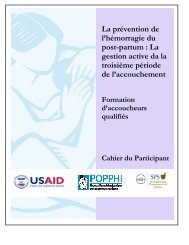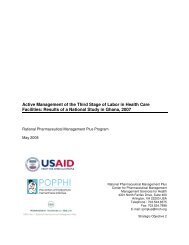English version PDF - POPPHI
English version PDF - POPPHI
English version PDF - POPPHI
Create successful ePaper yourself
Turn your PDF publications into a flip-book with our unique Google optimized e-Paper software.
Managing the third stage oflabor in peripheral healthcare settings: A guide to trainauxiliary midwivesAdditional funds for development of thisdocument were provided by Dr KennethKellner and a private donor to maternaland newborn health projects at PATH.Development of this document was made possible by This manual is made possible through support provided to the<strong>POPPHI</strong> project by the Office of Health, Infectious Diseases and Nutrition, Bureau for Global Health, US Agency forInternational Development, under the terms of Subcontract No. 4-31-U-8954, under Contract No. GHS-I-00-03-00028. <strong>POPPHI</strong> is implemented by a collaborative effort between PATH, RTI International, and EngenderHealth.
IntroductionThis flipchart was developed to help train auxiliary midwives to apply active management of the third stage of labor (AMTSL). It containscards with illustrations in a binder format showing the steps for AMTSL and monitoring the woman and the newborn in the immediatepostpartum period. The flipchart is designed to support training of low-literate birth attendants and presents key messages for applyingAMTSL. It may be used by:• Skilled birth attendants responsible for supervising auxiliary midwives working in health care facilities.• Program managers for postpartum hemorrhage initiatives.• Trainers involved in supporting and implementing training in AMTSL.The Flipchart for training auxiliary midwives should be used with checklists for AMTSL and monitoring the woman and newborn in theimmediate postpartum period. Trainers are encouraged to refer to the Reference Manual developed for training skilled birth attendants inAMTSL for any additional information (<strong>POPPHI</strong>. Prevention of Postpartum Hemorrhage: Implementing Active Management of the ThirdStage of Labor (AMTSL): A Reference Manual for Health Care Providers. Seattle: PATH; 2007).Purpose of the FlipchartFor the healthcare worker, the flipchart:• Is a reference on AMTSL and monitoring in the immediate postpartum period.• Describes steps for applying AMTSL.• Reminds birth attendants about danger signs in the newborn and postpartum woman.• Contains scripted messages and open-ended questions to facilitate the session.The picture and caption on the front of each card help learners understand the key points, reinforce messages and serve as a visualfocus.
How to Use the FlipchartYou can use this flipchart for group or individual training sessions. The cards should be used as a guide. Be sure to tailor allmessages to your learners’ level of understanding, using words they understand. Respond to learners’ concerns andquestions as they arise.• To become familiar with the content, read through and study all the cards before using them. Review the “Questions” and“Key Messages” for each card. Refer to the Reference Manual as needed.• When using the flipchart, place the entire binder on a table or, if you don’t have a table, hold it on your lap. Ensure that thelearner(s) can see each illustration and the trainer, the corresponding objectives and script.oooooPosition the illustration (or front of the card) to face the learner(s).Show one illustration at a time, giving learners a few moments to look at each picture.Position the back of the card (the side with the objectives and script), so that it faces the trainer. Use the script to guideyour explanation of each topic.Use the “Questions” on each card to facilitate discussion.Allow time for learner(s) to answer and ask questions, and provide further information and/or support when necessary.• When you have finished presenting a card and there are no more questions, go on to the next card.PLEASE NOTE: Prior to using this flipchart, add country- or clinic-specific information as needed. Refer to the AMTSLReference Manual for additional information.
Prepare for active management of the third stage of labor – Handwashing.• The steps in hand washing are:- Remove watches, bracelets, and rings.- Nails should be short and without nail polish; artificial nails should not be worn.- Wet hands with running water.- Rub hands together with soap and lather well up to the elbows, covering all surfaces for 15-30 seconds.- Weave fingers and thumbs together and slide them back and forth, taking care to rub well between the fingers and the back of thehand.- Rinse hands under a stream of clean, running water until all soap is gone.- Blot hands dry with a clean, dry towel or air-dry them; air-drying is the best, especially when sterile gloves have to be worn.If there is no running water, hands should not be dipped inside the bowl of water; instead, the watershould be poured over the hands from another container.QUESTIONS1) Why is handwashing important?2) When should providers wash their hands?KEY MESSAGES• Hands are the most common vehicle for transmitting infections. Handwashing is one of the most important infection preventionpractices, but it is often overlooked. It is essential that all staff who come in contact with clients understand the importance of goodhandwashing practices.• Hand washing significantly reduces the number of potentially infection-causing organisms on health workers’ hands and decreases theincidence of client sickness and death due to clinic-acquired infections. It also protects the health worker from contact with blood andother body fluids.• Wash hands on the following occasions:- immediately when you arrive at work.- before examining each client (mother or baby).- after examining each client (mother or baby).- before putting on gloves for clinical procedures (such as a pelvic exam or an IUD insertion).- after touching any instrument or object that might be contaminated with blood or other body fluids, or after touching mucousmembranes.- after removing any kind of gloves (hands can become contaminated if gloves contain tiny holes or tears).- after using the toilet or latrine.- before leaving work.
Prepare for active management of the third stage of labor - Handwashing.Card 1a
Prepare for active management of the third stage of labor.• Before the woman gives birth, prepare the syringe with oxytocin in it and have sterile / high level disinfected (HLD) instruments forcutting the cord. [Oxytocin in the uterotonic drug of choice. If this is not available then prepare a syringe with ergometrine orSyntometrine in it. If injectable uterotonic drugs are not available, prepare misoprostol tablets.] NEVER give ergometrine orSyntometrine to a woman who has high blood pressure or has pre-eclampsia or eclampsia.• Protect yourself and your clients from infection by wearing gloves, glasses, a water-proof apron, and closed shoes.• Make sure the room is warm so the baby doesn’t get coldQUESTIONS1) Why should you prepare the syringe before the woman has given birth?2) How are you protecting the baby by having sterile / high level disinfected (HLD) instruments for cutting the cord?3) How can you protect yourself against infections in the woman’s blood or body fluids when you are helping her during labor andchildbirth?KEY MESSAGESCard 1b• It is important to get everything ready before the woman is pushing because when the baby is born, many things are happening at thesame time and you may not have time to prepare the syringe.• Unsterile or dirty instruments can cause tetanus and other serious infections in the baby may cause serious illness or even death.• You can protect yourself and your client by following these simple rules:- Always assume that every person (client or staff) is potentially infectious.- Wash your hands regularly and frequently – before and after touching the client, before and after wearing gloves, after accidentallytouching blood or body fluids.- Wear gloves before touching anything wet—broken skin, mucous membranes, blood, or other body fluids.- Change gloves as often as you need to!!!- Remove gloves before leaving the client’s side.- Use protective clothing (aprons, face masks, eye goggles) when splashes or spills of body fluids are expected and during delivery.- Prevent splashes from blood or amniotic fluid: Avoid rupturing membranes during a contraction; Stand to the side when rupturingmembranes to avoid splashes from amniotic fluid; Avoid snapping the gloves when removing; Place items gently into thedecontamination bucket- Use safe work practices (e.g., do not recap or bend needles). Follow guidelines for handling and cleaning instruments and disposingof sharps and medical waste.- Always wear gloves when handling the placenta and dispose of it according to facility policies.
Prepare for active management of the third stage of labor.CapGlassesApronSterileglovesClosedshoesCard 1b
Card 2Dry the baby, keep her warm next to the mother’s skin, cover her with a warm, dry cloth, and makesure she is breathing. After the baby is born, immediately dry the baby and make sure the baby is breathing. If the baby is breathing well, then place the baby on the mother’s abdomen – stomach-to-stomach and skin-to-skin. Remove the cloth you used to dry the baby and then cover the baby, including her head, with a dry cloth or towel to prevent heatloss. Make sure the baby’s head is always covered.QUESTIONS1) Why should you dry the baby immediately?2) How can you tell if the baby is breathing all right?3) Why should you put the baby in skin-to-skin contact with her mother?4) Why is it important to keep the baby’s head covered?KEY MESSAGES The newborn cannot regulate its temperature as well as an adult. The new baby cools down or heats up much faster than a child. Thesmaller the newborn, the greater the risk of temperature problems. The newborn baby loses heat in four different ways: 1) by evaporation of amniotic fluid from the body 2) by transferring its body heatto any cold surface the baby touches (e.g. a table, weighing scale or cold mattress), 3) by exposure to cooler surrounding air, and 4)by transferring its body heat to cooler objects nearby.The baby can lose body heat very quickly, which can lead to very serious problems. Dry the newbornimmediately and keep her warm always. Skin-to-skin contact is an effective method of preventing heat loss in newborns, whether they be full term or preterm babies. Themother's chest or abdomen is the ideal surface to receive the newborn as it is clean and at just the right temperature. Keeping the baby’s head covered is an important way to prevent heat loss and keep the baby warm. If the baby is crying or breathing at least 30 times per minute within 30 second after birth, the baby is all right. If, however, the babyis not crying, is gasping, or is breathing at least 30 times per minute within 30 seconds of birth, call for help and begin resuscitation.
Dry the baby, put her on her mother’s abdomen, keep her warm next to the mother’sskin, cover her with a warm, dry cloth, and make sure she is breathing.Card 2
Card 3See if there is another baby. Gently feel the woman’s abdomen to see if there is another baby (twin).QUESTIONS1) Why should you check to see if there is another baby?KEY MESSAGES After the baby is born, you will need to check to see if there is another baby. This is important for several reasons:– If there is another baby, you must prepare yourself to attend with the birth.– If there is another baby, you should not give a drug, like oxytocin or misoprostol, which will stimulate uterine contractions tohelp deliver the placenta. If you give oxytocin or misoprostol before the baby is out, the cervix may close down and trap thebaby inside the uterus.
See if there is another baby.Card 3
Card 4After making sure there are no more babies, give oxytocin within one minute after birth of baby tomake the uterus contract.• If there is another baby, wait for the birth of the last baby before applying AMTSL.• If there is not another baby, FIRST tell the mother that you would like to give her a medication that will help the placenta come outand prevent bleeding. Ask her if you can go ahead.• Begin AMTSL (delivery of the placenta) by giving the woman 10 IU of oxytocin IM in the upper thigh within one minute after birth ofthe last baby. If the facility does not have oxytocin, give ergometrine 0.2 mg IM, or Syntometrine 1 mL IM, or misoprostol 600 mcgorally.Remember that oxytocin is the drug of choice for active management of the third stage of labor!!• If available, a qualified assistant should give the injection while you care for the woman and baby.• This should be done within one minute of childbirth.• You should only give an injection if you have been trained and are allowed to do it.QUESTIONS1) How does oxytocin help the placenta come out?2) Why is it important to give the injection within 1 minute after the last baby is born?KEY MESSAGES• Oxytocin is a medicine that helps the uterus to contract (become hard). When the uterus becomes hard, this helps the placentaseparate from the wall of the uterus and then come out. Because the uterus is contracted, there is also less bleeding.• Oxytocin takes 2-3 minutes to stimulate the uterus to contract, so you need to give it as soon as possible after the baby is born.
After making sure there are no more babies, give oxytocin within one minute afterbirth of baby to make the uterus contract.Card 4
Card 5Give misoprostol (if oxytocin is not available) to make the uterus contract after all babies are born.• If there is another baby, wait for the birth of the last baby before applying AMTSL.• If there is not another baby, FIRST tell the mother that you would like to give her a medication that will help the placenta come outand prevent bleeding. Ask her if you can go ahead.• Begin AMTSL (delivery of the placenta) by giving the woman giving the woman 600 mcg (3 tablets of 200 mcg) by mouth with a glassof clean water.Remember that oxytocin is the drug of choice for active management of the third stage of labor!!• If available, a qualified assistant should give the tablets while you care for the woman and baby.• This should be done within one minute of birth of the last baby.QUESTIONS1) Is misoprostol better than oxytocin?2) How does misoprostol help the placenta delivery?3) Why is it important to give the tablets within 1 minute after the last baby is born?KEY MESSAGES• Oxytocin is the best medicine to use for helping the placenta come out. If you are not allowed to give injections or you do not haveoxytocin, you may use misoprostol to help the uterus contract and the placenta to come out.• Misoprostol is a medicine that helps the uterus to contract (become hard). When the uterus becomes hard, this helps the placentaseparate from the wall of the uterus and then come out. Because the uterus is contracted, there is less bleeding also.• Misoprostol takes 3-5 minutes to stimulate the uterus to contract, so you need to give it as soon as possible after the last baby is born.
Give misoprostol (if oxytocin is not available) to make the uterus contract after all thebabies are born.Card 5
Card 6Never give misoprostol or oxytocin to a pregnant woman or a woman in labor.• Misoprostol and oxytocin should only be given to the woman AFTER the baby has been born and you are sure there is not anotherbaby in the woman’s uterus.• Use of oxytocin or misoprostol during labor is only authorized in health care facilities that have capacity to perform a cesareanoperation should one be needed.QUESTIONS1) What might happen if a woman receives an IM injection of oxytocin or misoprostol tablets while she is still pregnant (the baby is still inher uterus)?2) What should you do if a woman or her family asks you to give an injection or tablets to speed up her labor?KEY MESSAGES• Misoprostol and oxytocin are powerful medicines that make the uterus contract. If you give either of these medicines to a woman whois still pregnant, contractions may be so hard that:− the mother’s blood flow to her baby may slow down, which could cause severe damage to the baby in the womb.− The uterus may tear, which could kill the baby, cause severe bleeding in the woman, and may kill her if she cannot haveimmediate surgery.• Sometimes it is hard to refuse a woman or her family when they ask you to give injections or tablets to “speed” up the labor. You mustexplain about the dangers of mis-using these powerful medications to the woman and her family, and show them other ways to speedup the labor or to reduce the pain. NEVER give these strong medicines to women in labor.• If you think that a woman’s labor is not progressing as it should (because the baby is blocked from coming out or some other reason),you should help transport her to a health center or hospital immediately, to be seen by a qualified midwife or doctor.
Never give misoprostol or oxytocin to a pregnant woman or a woman in labor.Card 6
Card 7Clamp and cut the cord after cord pulsations have ceased or approximately 2-3 minutes after birth ofthe baby, whichever comes first.• Wait to clamp and cut the cord until the cord stops pulsating or 2–3 minutes after the baby’s birth, whichever comes first.NOTE: Refer to national protocols for cord cutting if the woman is infected with HIV.NOTE: Clamp and cut the cord immediately if the baby is not breathing.• Place one clamp or tie about 4 cm from the baby’s stomach.• Gently milk the cord towards the woman’s perineum and place a second clamp or tie on the cord approximately 1 cm from the firstclamp. Milking the cord towards the mother will reduce blood spurts when you cut the cord. Do NOT milk the cord towards the baby.Never milk the cord towards the baby!• Cut the cord using sterile scissors, covering the scissors with gauze to prevent blood spurts. Do NOT use the same scissors used forepisiotomy.• Tie the cord only after all steps of AMTSL are complete and initial care of the mother and baby has been provided.QUESTIONS1) Why is it important to wait until the cord stops pulsating, or 2-3 minutes after the baby’s birth, to tie and cut the cord?2) Why must you wait until after the placenta is delivered to tie and care for the cord?3) Why should you use a sterile, new scissors for cutting the cord instead of using the same scissors used on the mother?KEY MESSAGES• Delaying cord clamping can help to prevent anemia in babies and increase the duration of early breastfeeding.• If you take time to tie the cord instead of delivering the placenta, the placenta may sit in the vagina with blood behind it.• The mother may have any number of infections that are passed in the blood, including HIV and Hepatitis B. If you use the samescissors used on the mother for cutting the cord, you may introduce these infections into the baby.
Clamp and cut the cord after cord pulsations have ceased or approximately 2-3minutes after birth of the baby.•Card 7
Card 8Put the baby on the mother’s chest, in skin-to-skin contact.• After you have cut the cord, place the infant directly on the mother’s chest, on her stomach, with the newborn’s skin touching themother’s skin.• Cover both the mother and infant with a dry, warm cloth or towel to prevent heat loss.• Cover the baby’s head with a cloth or, if available, a cap.• If the mother is not able to hold the baby, ask her companion or an assistant to care for the baby. Otherwise, the baby should remainwith the mother.If at all possible, do not separate the woman and her newborn.QUESTIONS1) Why should you put the baby on the mother’s chest after cutting the cord?2) Should you put the baby on the mother’s chest if the mother has chosen NOT to breastfeed?KEY MESSAGES• Putting the baby on the mother’s chest, in skin-to-skin contact, serves five purposes:– Skin-to-skin contact keeps the baby warm– When the mother and baby are together, the mother can quickly notice if there is a problem and call you– Being close to the mother stimulates breastfeeding– Early and close contact between the mother and baby help them to bond– When the baby is lying on the mother, you can keep a close eye on both the mother and the baby at the same time.• Even if the mother has chosen NOT to breastfeed, skin-to-skin between the mother and baby still has all of the other benefits listedabove.
Put the baby on the mother’s chest, in skin-to-skin contact.Card 8
Card 9Wait for a uterine contraction.• Place the clamp close to the woman’s perineum.• Place the palm of the other hand on the lower abdomen just above the woman’s pubic bone to feel for uterine contractions.Do NOT massage the uterus at this point.• Keep slight tension on the cord.• Await a strong uterine contraction (2–3 minutes).QUESTIONS1) Why should you wait for a uterine contraction?2) How will you be able to tell if the woman is having a contraction?3) Why shouldn’t you massage the uterus before the placenta is out?KEY MESSAGES• The uterotonic drug will stimulate a contraction that will help separate the placenta from the uterine wall.• You can tell the woman is having a contraction in the following ways:- You will feel the uterus “rise up” and become hard- The woman may tell you that she is having pain or having a contraction.• Do not massage the uterus before the placenta is out because this may confuse the uterus and cause the cervix to close down andtrap the placenta inside.
Wait for a uterine contraction.Card 9
Card 10Do controlled cord traction (CCT) while supporting the uterus.• When there is a uterine contraction, support the uterus by pushing upward on the uterus (countertraction) with the hand above thepubic bone (apply pressure on the uterus in an upward direction—towards the woman’s head).• While you push toward the woman’s head to hold the uterus up, use your other hand on the clamp to pull with firm, steady tractiondownward on the cord (controlled cord traction), following the direction of the birth canal.• If the placenta does not descend during 30 to 40 seconds of controlled cord traction and there are no signs of placental separation),stop controlled cord traction.• Gently hold the cord and wait until the uterus is well contracted again. If necessary, clamp the cord closer to the perineum as itlengthens.• When there is another contraction, repeat the steps above.QUESTIONSIf the placenta does not separate from the uterine wall after four attempts of cord traction, consider the possibility ofplacenta accreta and prepare the woman for a surgical intervention.1) How does controlled cord traction help deliver the placenta?2) Why should you only do controlled cord traction when the uterus is contracted?3) Why should you push upward on the uterus when you are doing controlled cord traction?4) What should you do if the cord tears while you are doing controlled cord traction?KEY MESSAGES• Controlled cord traction helps deliver the placenta that has already separated from the uterus. In other words, it makes sure that theplacenta comes out of the uterus as soon as it is separated. If the placenta is separated from the uterus but stays inside the uterus,the uterus cannot contract and the woman will bleed.• Controlled cord traction should not be used to separate the placenta from the uterine wall – if too forceful controlled cord traction isapplied and the placenta is not separated, you may pull the uterus out with the placenta.• The placenta will separate during uterine contractions. If you apply controlled cord traction when the uterus is NOT contracted, youmay pull the uterus out. This is a very serious problem that may cause the woman to bleed heavily.• Pushing upward on the uterus while applying controlled cord traction will prevent the uterus from coming out.• If there is a ruptured cord, ask the woman to squat and deliver the placenta with maternal effort and gravity. If the placenta still doesnot come out, you may need to consider manual removal of the placenta.
Do controlled cord traction while supporting the uterus.•Card 10
Card 11Gently deliver the placenta.• Do not release support on the uterus until the placenta is visible at the vulva.• As the placenta delivers, hold it in both hands and gently turn it until the membranes are twisted.• Slowly pull to complete the delivery. Move membranes up and down until they deliver.• Place the placenta in the receptacle provided (for later examination).QUESTIONSRoutine manual exploration of the uterus is strongly discouraged because it increases therisk of infection for the woman and is extremely painful.1) Why should you gently turn the placenta as you are delivering it?2) What should you do if the membranes tear as you are delivering the placenta?KEY MESSAGES• You will prevent the membranes from tearing by gently turning the placenta as you deliver it.• If the membranes tear, gently examine the upper vagina and cervix wearing sterile gloves and use a sponge forceps to remove anypieces of remaining membrane.
Gently deliver the placenta.Card 11
Card 12Massage the woman’s uterus.• Massage the uterus immediately after delivery of the placenta and membranes until it is firm.• After stopping massage, it is important that the uterus does not relax again.QUESTIONS1) Why should you massage the uterus after the placenta has been delivered?2) Why is it important to make sure the uterus does not relax (become soft) after you have massaged it?KEY MESSAGES• The uterus needs to contract to stop bleeding in the area that the placenta separated from it. If the uterus is soft, blood will comegushing out of that area and could cause the woman to bleed heavily and maybe die.• You should massage the uterus for two reasons:– Massaging the uterus stimulates uterine contractions and helps to prevent bleeding from the site in the uterus where theplacenta separated.– Sometimes blood clots build up in the uterus and may prevent the uterus from contracting. These blood clots in the uterus aresometimes expelled during this process.• The uterus may become soft as soon as you finish massaging it. If this happens, the woman could bleed heavily. You should alwaysmake sure that the uterus stays hard after you have massaged it.
Massage the woman’s uterus.Card 12
Card 13Teach the woman how to massage her own uterus and tell if it is not well contracted.• Teach the woman how to massage her own uterus and how to tell that it is firm.• Ask her to call if her uterus becomes soft.QUESTIONSN.B. Even if you teach the woman how to massage her own uterus, you still need to regularlycheck the woman’s uterus to make sure it is firm and not soft.1) Why should you teach the woman how to massage her own uterus?KEY MESSAGES• You should teach the woman how to massage her own uterus for two reasons:– The woman will always be with her uterus, so if she knows how to massage her own uterus and how to tell if it is soft, youknow that she will call you immediately if there is a problem.– You may sometimes be busy or have to look in on another woman and may not be able to check the woman’s uterus as oftenas you need to.
Teach the woman how to massage her own uterus and tell if it is notwell contracted.•Card 13
Card 14Carefully examine the placenta.• Hold the placenta in the palms of the hands, with maternal side facing upwards.• Check whether all of the lobules are present and fit together.• Hold the cord with one hand and allow the placenta and membranes to hang down.• Insert the other hand inside the membranes, with fingers spread out.• Inspect the membranes for completeness.• If membranes or placenta are not complete, take immediate action.• Dispose of the placenta according to national protocols.QUESTIONS1) Why is it important to carefully and completely check the placenta?2) Should you routinely do a manual revision of the uterus to make sure that the uterus is empty?3) How should you dispose of the placenta?KEY MESSAGES• If the placenta is not complete and part of it remains in the uterus:– the uterus cannot contract properly and the woman will continue to bleed.– they can become infected and cause the woman to become very ill or even die.• It is NOT recommended to routinely do a manual revision of the uterus after the placenta has delivered. Some birth attendants like todo a manual revision routinely but this practice is very dangerous and painful and is not necessary UNLESS there are bits of theplacenta left in the uterus. It is much easier and safer to carefully check the placenta to see if there are pieces of the placenta leftinside the uterus.• Every facility has rules and regulations around disposing of the placenta. You should be aware of how you are supposed to dispose ofit. The important thing to remember is that the placenta is potentially very infected and should be handled with great care.
Carefully examine the placenta.Card 14
Card 15Carefully examine the woman’s external genitals.• Direct a strong light onto the perineum.• Gently separate the labia and inspect the lower vagina for lacerations.• Inspect the perineum for tears.• If you have been trained to do so, repair the tears. If you have not been trained to do so, apply pressure to the tear to stop bleedingand help the woman get to a skilled birth attendant as soon as possible• Gently cleanse the vulva, perineum, buttocks, and back with warm water and a clean compress.• Apply a clean pad or cloth to the vulva.• Evaluate blood loss.• Explain all examination findings to the woman and, if she desires, her family.QUESTIONS1) Why is it important to carefully and completely check the woman’s genitals for tears?2) What could happen if the woman does not get her tears repaired?KEY MESSAGES• It is important to carefully examine the woman’s external genitals because tears, large or small, can cause the woman to lose a lot ofblood which could either maker her very weak and sick or could kill her.• By carefully examining every woman, you will be able to quickly detect if she has any tears and make sure that they get repairedbefore she has lost too much blood.• If the woman has tears that are not repaired:– She could lose a lot of blood, become anemic, or even die.– She might get an infection where the tears are.– She might have pain or other problems when she wants to start having sex with her partner again.
Carefully examine the woman’s external genitals.Card 15
Card 16Facilitate breastfeeding, if this is her choice for infant feeding.• During recovery, assist the woman to breastfeed if this is her choice.• Keep the baby in skin-to-skin contact with her mother when providing care to the woman (placenta delivery, suturing of genital tears),during transfer to the postnatal ward and for the first hours after birth.• Skin-to-skin contact can also be used afterwards to keep the baby warm if the room is cool, for example at night, or to rewarm a babythat is found to be mildly hypothermic.QUESTIONS1) Why is it important to help the baby breastfeed during the first hour after birth?2) For how long should the baby be exclusively breast or formula fed after birth?KEY MESSAGES• Newborn babies should be kept close to their mothers and begin breastfeeding within one hour of birth.• Having the baby start to breastfeed soon after birth stimulates the production of the mother's breastmilk. It also helps the mother'suterus contract, which reduces the risk of heavy bleeding or infection.• Breastmilk alone is the only food and drink an infant needs for the first six months. No other food or drink, not even water, is usuallyneeded during this period. Even in hot, dry climates, breastmilk meets a young baby's need for fluids. Water or other drinks are notneeded during the first six months. The baby needs no other food or drink while waiting for the mother's milk supply to increase.• The baby should be allowed to breastfeed as often as he or she wants.• From birth, the baby should breastfeed whenever he or she wants to. If a newborn sleeps more than three hours after breastfeeding,he or she may be gently awakened and offered the breast.• If a mother gives birth in a hospital or clinic, she has a right to expect that her baby will be kept near her in the same room, 24 hoursa day, and that no formula or water will be given to her baby if she is breastfeeding.• A newborn baby needs to remain in skin-to-skin contact with the mother as much as possible. It is best for the mother and baby tostay together in the same room or bed. Colostrum, the thick yellowish milk the mother produces in the first few days after birth, is theperfect food for newborn babies. It is very nutritious and helps protect the baby against infections. Sometimes mothers are advisednot to feed colostrum to their babies. This advice is incorrect.• Frequent breastfeeding causes more milk to be produced. Almost every mother can breastfeed successfully.• Breastfeeding helps protect babies and young children against dangerous illnesses. It also creates a special bond between mother andchild.
Facilitate breastfeeding, if this is her choice for infant feeding.Card 16
Card 17Carefully monitor the woman after childbirth.• Before beginning, tell the woman what will be done.• During the first two hours after the delivery of the placenta, monitor the woman at least every 15 minutes (more often if needed) to:− Palpate the uterus to check for firmness.− Massage the uterus until firm. (Ask the woman to call for help if bleeding increases or her uterus gets soft.)− Check for excessive vaginal bleeding.− Take action to evaluate and treat PPH immediately if excessive bleeding is detected.− Ensure the uterus does not become soft after massage is stopped.• Share findings with the woman.• Instruct the woman how the uterus should feel and how she can massage it herself.• Encourage the woman to eat and drink.• Ask the companion to stay with the woman.• Encourage the woman to pass urine.• Inform the woman about danger signs and when she should call for help.• Advise on postpartum care and hygiene.• Ensure the mother has sanitary napkins or clean material to collect vaginal blood.• Ask the mother’s companion to watch her and call for help if bleeding or pain increases, if mother feels dizzy or has severe headaches,visual disturbance or epigastric distress.QUESTIONS1) How will you know if the woman is bleeding too much?2) What will you do if the woman is bleeding too much?KEY MESSAGES• Signs that a woman is bleeding too much include:– Increase in bleeding or more than 2 or 3 pads soaked in 20-30 minutes or 2 2-meter cloths soaked in blood– Bleeding that occurs at a slow rate over several hours.– The woman suddenly enters shock – pale (especially inner eyelids, palms or around mouth); sweatiness or cold clammyskin; rapid breathing (rate of 30 breaths per minute or more); anxiousness, confusion or unconsciousness; scanty urineoutput (less than 30 mL per hour).• If a woman is bleeding too much, you should plan to make sure the woman is seen by a skilled birth attendant; in the meantime, youshould: Massage the uterus. Give oxytocin 10 IU IM or misoprostol 600 mcg orally or under her tongue (sublingually). Make sure thewoman’s bladder is empty. Recheck the placenta to make sure it is complete. Recheck her genitals to make sure there are no tears. Ifthe woman is not in shock, provide oral fluids.
Carefully monitor the woman after childbirth.Card 17
Card 18Carefully monitor the baby.Keep the mother and baby together. Check the baby at the same timethat the mother is being checked. Before beginning, explain what you are doing to the mother / parents. Ensure the room is warm (25°C). Every 15 minutes during the first 2 hours after delivery of the placenta, you should check the baby’s:– Breathing– Colour– Temperature of the feet (if they are cold, check axillary temperature)– Cord stump for bleeding (retie or tie more tightly if there is bleeding)• Share all findings with the mother / parents. Respond immediately if there are any problems identified.QUESTIONS1) How can you maintain the body temperature of the newborn?2) How can you check the body temperature of the newborn?KEY MESSAGES• In order to maintain the temperature of the newborn at birth:– Make sure the room is clean, warm (at least 25 - 28°C), and free from draughts from open windows and doors, or from fans.– Keep the newborn in skin-to-skin contact with her mother.– Begin breastfeeding as soon as possible after birth, preferably within the first hour.– Bathing should not be carried out before 6 hours after birth, and preferably on the second or third day of life.– Before weighing the baby, she should be well wrapped. The weight recorded can then be adjusted by subtracting the weight ofthe covers.– Newborns should be adequately protected from exposure to ambient temperature by clothing and bedding.– Babies should be kept with their mothers 24 hours a day, preferably in the same bed, in a warm room (at least 25°C).• Take the axillary temperature of the baby with a digital thermometer cleaned with an alcohol swab (normal = 36.5-37.5 °C) at leastonce in the six hours. At other times, at least verify the body temperature by touching the abdomen, palms, and soles and ensure thatthey are all warm. If they are cold, recheck axillary temperature.• If the palms and soles are cold or blue, it suggests that the baby is not warm enough. If the abdomen is cold, it suggests an evenmore severe hypothermia. Rewarm the baby, preferably by placing in skin-to-skin contact with the mother’s chest and covering thebaby with layers of clean cloth and a blanket. If, however, this does not warm the baby, it represents a serious danger sign thatnecessitates urgent referral.
Carefully monitor the baby.Republic of SenegalMinistry of Health andMedical PreventionCard 18
Card 19Recognize and teach danger signs in the newborn.• Illness in the newborn can become serious quickly and put the baby’s life in danger.• To save babies' lives, is important that the mother and the family members know how to recognize danger signs in the newborn thatrequire immediate care by a qualified health care provider.• Advise the parents to go to a hospital or health centre immediately, day or night, WITHOUT WAITING , if any ONE of the followingsigns is present:– Refuses to breastfeed or sucks poorly.– Is moving less or is inactive/lethargic.– Feels too hot or too cold.– Has rapid or difficult breathing, with chest retractions, or grunting.– Has a convulsion.– Has a distended tummy or is vomiting up everything he/she eats.– Has pus or a bad smell from the umbilicus, or the base of the cord is red or swollen.– The color is abnormal: jaundice, blue (cyanosis), or pale.– Inconsolable crying….QUESTIONS1) How many danger signs should the baby have before the parents bring her for care?2) What should the parents do when they recognize danger signs?KEY MESSAGES• Advise the parents to go to a hospital or health centre immediately, day or night, WITHOUT WAITING, if any ONE danger sign ispresent.• Parents to go to a hospital or health centre immediately, day or night, WITHOUT WAITING.
Recognize and teach danger signs in the newborn.•Republic of SenegalMinistry of Health andMedical PreventionCard 19
Card 20aRecognize and teach danger signs in the postpartum woman.Advise the woman to go to a hospital or health centre immediately, day or night, WITHOUT WAITING, if she has any ONE of the followingsigns:• Increase in bleeding or more than 2 or 3 pads soaked in 20-30 minutes.• Convulsions.• Fast or difficult breathing.• Fever and too weak to get out of bed.• Severe abdominal pain.QUESTIONS1) Why is it important to tell the woman to go immediately, day or night, WITHOUT WAITING to a hospital or health center if she hasany one of the signs listed above?KEY MESSAGES• Positive outcomes depend on how soon a diagnosis is made and how quickly effective treatment is provided after a complicationbegins.
Recognize and teach danger signs in the postpartum woman.-Card 20a
Card 20bRecognize and teach danger signs in the postpartum woman.Advise the woman go to a health centre as soon as possible if she has any of the danger signs listed below:• Fever• Abdominal pain• Feels ill• Breasts swollen, red or tender breasts, or sore nipple• Urine dribbling or pain on urinating• Pain in the perineum or draining pus• Foul-smelling lochiaQUESTIONS1) Why is it important that a woman go to a health centre as soon as possible if she experiences any of the danger signs listed above?KEY MESSAGES• Positive outcomes depend on how soon a diagnosis is made and how quickly effective treatment is provided after a complicationbegins.
Recognize and teach danger signs in the postpartum woman.Card 20b


